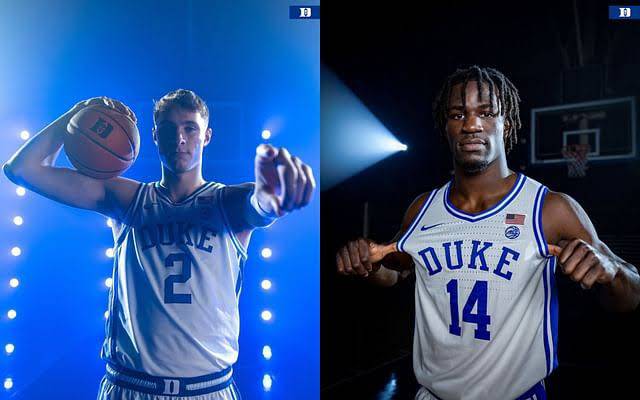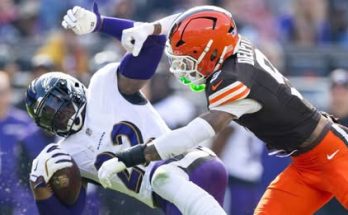The college basketball world was left reeling when news broke that a five-star recruit, widely regarded as one of the most talented players in his class, made the decision to decline a $6.5 million NIL deal, decommit from the University of Tennessee, and ultimately chose to play for the University of Kentucky over perennial powerhouse Duke. This seismic shift in the recruiting landscape has sent shockwaves through the basketball community, leaving fans, coaches, and analysts scrambling to understand what led to such a bold and unexpected move.
To understand the magnitude of this decision, it’s important to first understand the significance of the player at the center of it all. The recruit, whose name has become synonymous with the future of college basketball, is one of the most coveted prospects in recent memory. His combination of size, athleticism, skill, and basketball IQ has made him a projected top-five pick in the upcoming NBA draft, and his decision was expected to shape the trajectory of several college programs. Tennessee, Duke, and Kentucky had all placed their bets on landing the prodigy, but no one could have predicted the sudden shift in allegiance.
For Tennessee, the decision was particularly painful. The Vols had managed to secure a commitment from this recruit in what was hailed as a major victory for their basketball program. Under head coach Rick Barnes, Tennessee has consistently been a contender in the SEC and has built a reputation for developing NBA-caliber talent. The recruit was seen as the piece that would elevate Tennessee to the next level, potentially making them a perennial title contender. The $6.5 million NIL deal, which was reportedly one of the largest in college basketball history, only added to the allure of the Vols’ offer. It was a deal that seemed almost too good to turn down, particularly for a player who had long dreamed of achieving financial independence through his basketball career.
But in a stunning move that left many questioning the changing dynamics of college basketball recruitment, the recruit announced his decommitment from Tennessee. The news was delivered in a statement that was brief but powerful, offering little explanation beyond the fact that he had reconsidered his future and was making a decision based on what was best for him, both on and off the court. This marked the beginning of an unprecedented sequence of events that would leave the basketball world in disbelief.
What followed next was even more shocking: the recruit’s choice to ultimately commit to Kentucky over Duke, two of the most storied programs in college basketball history. Kentucky, under head coach John Calipari, has long been a destination for elite talent, with numerous NBA stars having passed through its ranks. Duke, led by legendary coach Mike Krzyzewski until his retirement in 2022, has also established itself as a powerhouse, consistently competing for national titles and sending players to the NBA. The recruit’s decision to bypass both of these blue-blood programs, which had long been considered the favorites, was viewed as a dramatic shift in the landscape of college basketball recruiting.
So, what led to such a monumental decision? Many factors appear to have played a role in this surprising turn of events, and understanding them requires a closer look at the evolving landscape of college basketball, the role of NIL deals, and the competing philosophies of the programs involved.
At the heart of the decision is the changing nature of college basketball recruitment, particularly with the advent of NIL (Name, Image, and Likeness) deals. In the past, players were largely limited to their scholarship offers and the prestige of their chosen program when making a decision about where to play. But with the introduction of NIL, the recruiting process has become a far more complex equation. Top-tier recruits now have the ability to capitalize on their name, image, and likeness, and programs have become more willing than ever to offer lucrative deals to entice players to commit.
In this case, the $6.5 million NIL deal from Tennessee was a game-changer, offering the recruit an unprecedented financial opportunity. It was a deal that would have set him up for financial success before even stepping onto a college court, and for many players, the allure of such a contract might have been impossible to resist. But for this particular recruit, the decision was not just about the money—it was about finding the right fit for his long-term goals. And that’s where Kentucky and Duke came into play.
Kentucky, with its storied history of developing NBA talent, has long been a destination for players looking to make the leap to the professional ranks. Under John Calipari, the Wildcats have built a reputation for prioritizing player development and pushing players to succeed at the highest level. For this recruit, the opportunity to play in a program that has consistently produced NBA stars may have been a major selling point. Calipari’s reputation for helping players get to the next level, combined with the Wildcats’ culture of winning and competition, may have outweighed the financial incentives offered by Tennessee.
On the other hand, Duke’s allure is based on its combination of elite player development, tradition, and academic prestige. The Blue Devils have a long-standing reputation for producing NBA talent, and coach Jon Scheyer, who succeeded Krzyzewski, has continued that legacy. But for this recruit, the decision may have come down to a feeling that he could accomplish his goals more effectively in a different environment. While Duke’s offer likely included significant NIL opportunities, it’s possible that the recruit felt that Kentucky’s system was better suited to his playing style and aspirations. Additionally, the prospect of playing under Calipari, who has become known for his ability to adapt to the ever-changing landscape of college basketball, may have been a key factor in his decision.
The decision to decline such a lucrative NIL offer also speaks to a broader shift in the priorities of top-tier recruits. While NIL deals have become an increasingly important factor in recruitment, players are beginning to recognize that money alone may not be enough to ensure long-term success. The focus is shifting from immediate financial gain to long-term development, both on the court and off. For this recruit, the choice was not just about the financial incentives; it was about finding a program that could help him grow as a player, prepare for the NBA, and ultimately shape his future.
In many ways, this recruit’s decision is a microcosm of the larger changes taking place in college basketball. The introduction of NIL deals has added a new layer of complexity to recruiting, with money now playing a central role in the decision-making process. But as this recruit’s choice demonstrates, the true value of a college basketball program is no longer determined solely by its financial offers or its historical prestige. Instead, players are becoming more discerning in their decisions, weighing factors like player development, system fit, and long-term goals more heavily than ever before.
For Tennessee, this decision represents a painful loss. The Vols were seen as a rising force in college basketball, and landing such a high-profile recruit would have propelled them into the upper echelon of the sport. For Duke, it’s another reminder of how quickly the college basketball landscape can change, with programs no longer able to rest solely on their historical success. And for Kentucky, it’s another win for a program that has built its reputation on developing elite talent and sending players to the NBA.
As for the recruit, this decision will be remembered as one of the most significant moments in college basketball recruiting history. It represents a shift in how elite prospects approach their futures, and it signals that, while money may be a factor, it is no longer the only factor in the decision-making process. The college basketball world will be watching closely as this player embarks on his journey at Kentucky, and the reverberations of this decision will be felt for years to come.



